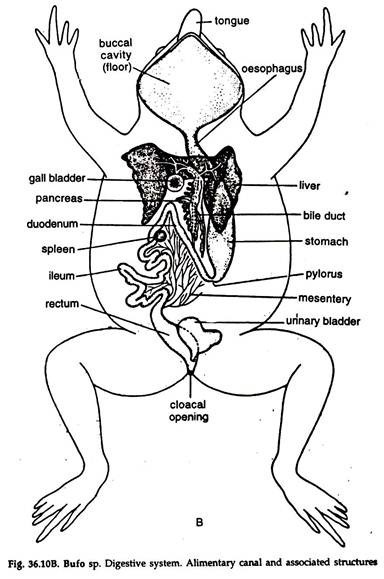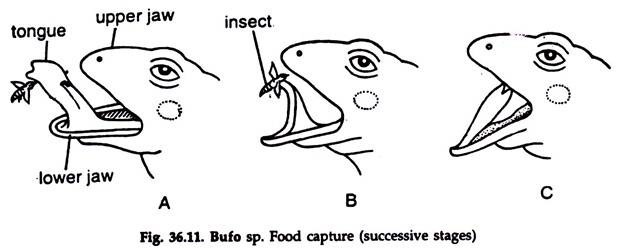In this article we will discuss about the functions of digestive system of a frog (toad), explained with the help of suitable diagrams.
The digestive system consists of an alimentary canal and its appendages, the digestive glands (Fig. 36.10B):
Digestion and absorption of food take place within the canal.
A. Alimentary Canal:
ADVERTISEMENTS:
The digestive tract can be divided into the following zones:
1. Buccal cavity:
The mouth is bounded by two toothless jaws—the upper and lower. The mouth leads into a wide buccal cavity.
ADVERTISEMENTS:
The structures (Fig. 36.10A) present in the buccal cavity are:
a. Two apertures—internal nares—the openings of the nostrils on the roof of the cavity towards anterior end.
b. A pair of projections on the roof, one on each side, due to downward bulging of the eyes.
c. Two apertures—the eustachian
apertures—at the angle of the jaws, one on each side. The eustachian tube is in communication with the tympanic cavity and mouth cavity.
ADVERTISEMENTS:
d. A large fleshy tongue on the floor. The tongue is attached with the front end, the posterior rounded end remaining free.
e. In male toad, an additional structure, the opening of the vocal sac, is present on the floor towards left side. The vocal sac is black-pigmented and situated beneath the floor of the mouth cavity, just covered by the skin.
f. A slit-like aperture, the glottis, just behind the tongue. Glottis communicates the mouth cavity with the lungs.
2. Pharynx:
The buccal cavity narrows posteriorly, and this region is known as pharynx.
3. Oesophagus:
The pharynx leads posteriorly to a short, narrow tube, the oesophagus or gullet. The oesophagus opens into a saclike stomach.
4. Stomach:
The stomach is divisible into an anterior wide chamber towards the oesophagus, the cardiac stomach and a posterior narrow portion, the pyloric stomach. Small intestine The pyloric stomach leads to a narrow tube, the small intestine. The junction of the stomach and small intestine is marked by a sharp constriction.
ADVERTISEMENTS:
Circular sphincter musdes forming the pyloric valve at the constriction regulate the flow of food from the stomach. The first portion of the small intestine lying parallel to the stomach is duodenum and the rest long, slender, much coiled portion is ileum.
5. Rectum:
The small intestine continues posteriorly as a wide tube, the rectum or large intestine. The rectum opens posteriorly into a short chamber, the cloaca, which opens to the exterior by an aperture, the cloacal aperture.
B. Digestive Glands:
Liver and pancreas are digestive glands:
1. Liver:
The liver is a large, reddish-brown, bilobed mass. The left lobe is larger than the right one and sub-lobed. The two main lobes are connected by a narrow, short, median portion. Between the two lobes, median in position, lies a small, thin-walled, greenish, rounded sac, the gall bladder. The secretion of the liver, the bile, is stored within the gall bladder. Fine ducts from the liver, the hepatic ducts, receive bile from the liver.
Some of the hepatic ducts enter the gall bladder and the others unite to form a duct, the bile duct. Cystic duct springs from the gall bladder and joins the bile duct. The duct passes through the substance of the pancreas and in its way receives ducts from the latter. The duct, which is now called common bile duct, receives secretions from both the liver and the pancreas and opens into the duodenum.
2. Pancreas:
The pancreas is a large, creamy-white, irregular gland, surrounding the bile duct, into which it pours its secretion, the pancreatic juice. It lies between the duodenum and the stomach.
Feeding and digestion:
The adult toad is carnivorous and lives on various types of animals, both large and small. Digestion is extracellular.
Food capture:
Large-sized animals are captured by the jaws. To capture small animals, like insects the tongue is used. When any food organism comes near a toad, it suddenly throws out the free end of its sticky tongue on the prey. The prey gets attached to the tongue and is taken into the buccal cavity. (Fig. 36.11).
Digestion:
The toad is toothless and cannot chew the food. The food taken into the mouth cavity is swallowed as a whole and passes down to the stomach via the oesophagus. Digestion begins in stomach. The purpose of digestion is to break down complex food substances like proteins, fats and carbohydrates into simpler compounds so that the cells of the alimentary tract may absorb them.
The breaking up of various food substances is done by specific ferments known as enzymes, which are secreted by various glands. Protein is partly broken down in the stomach into peptone by pepsin, in acid medium.
The partly digested food in the stomach passes to the duodenum through the pyloric valve, and is further digested by the action of pancreatic juice, which also neutralizes stomach acid. Bile helps in emulsification of lipids.
After the completion of digestion, the nutritive substances which are now in a liquid state are absorbed by the intestinal cells and passed to the blood. The undigested portion of the food, the excreta, is stored temporarily in the rectum, and finally thrown out to the exterior through the cloaca.
The internal lining of the digestive tract is different in structures in different regions, and is thrown into folds. The folds are irregular in the stomach, transverse and few in the duodenum, longitudinal and numerous in ileum.
The purpose of the folds is to increase the surface area. It is maximum in intestine, the chief site for absorption of nutrients. The whole alimentary tract is slung to the dorsal body wall by sheets of tissues, the mesenteries.

